The Astor Place, 445 Lafayette Street: Review and Ratings
at The Southwest corner of Astor Place View Full Building Profile
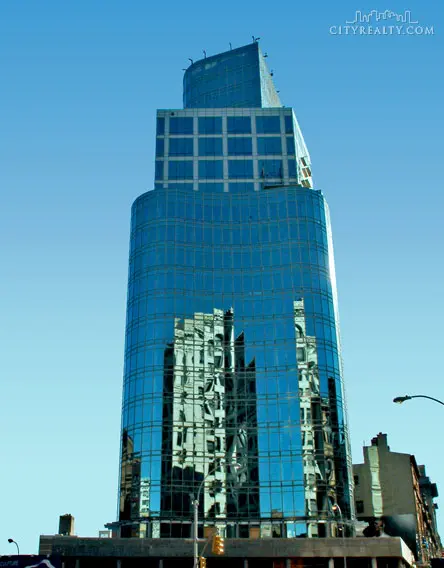

With its mid-section's undulating plan, the 21-story Astor Place at 445 Lafayette Street is one of the most distinctive residential towers in the city.
Above its limestone-clad base, the tower is mostly clad in glass and has 39 apartments with floor-to-ceiling windows.
Its very prominent location is at the intersection of Lafayette Street, Astor Place and Fourth Avenue and the crossroads of the East Village, Greenwich Village, the Bowery and NoHo.
Erected in 2004 by The Related Companies, one of the developers of the Time Warner Center at Columbus Circle, the project went through a long gestation with several of the world's most famous architects before it was finally designed by Gwathmey Siegel & Associates.
Cooper Union, which is across the street to the east from the site, which it owned, came up with a prepaid 99-year lease for Related, which created co-op apartments with condo rules for Gwathmey’s tower.
Bottom Line
Astor Place at 445 Lafayette Street, the gleaming, free-standing, mixed-use landmark of the East Village, anchors one of the city's great intersections and its jumbled form and spectacular views give hints of the neighborhood's rich and eclectic architectural stew.
Astor Place at 445 Lafayette Street marks the center of chaotically hip New York with many large and spectacular layouts and curved glass walls.
Description
With its sinuous curves, Astor Place is New York's answer to Chicago's famous Lake Point Tower designed by Shipporeit & Associates, a reflective glass structure whose curves wrap around a three-point plan that is one of the landmarks of modern architecture.
This tower is much smaller than the Chicago building, which is also more prominently sited on Chicago's lakefront.
This tower, however, does have considerable visibility as it is at the northern terminus of Lafayette Street at Astor Place and directly across Fourth Avenue from the landmark Cooper Union Building where East Eighth Street becomes St. Mark’s Place, the gateway to the East Village.
445 Lafayette Street is actually a more complex form than Lake Point Tower because the undulating façade of the mid-section of the residential tower is set back on a two-story commercial base that conforms to the traditional straight building lines of the property and is beneath a section near the top that is only curved at the rear. The smallest section is setback at the top and is fully curved.
Charles Gwathmey, the architect, referred to this project as "Sculpture for Living" and observed that it "has no front and no back."
It is steps away from St. Mark's Place and centered between the Gothic grace of Grace Church, the brownstone façades of Cooper Union, the punctuated screens of Morphosis's new building at Cooper Union and the slanted modernism of Carlos Zapata's nearby hotel on the Bowery.
There is considerable traffic at this location and excellent public transportation with numerous subway and bus lines within two blocks. The area abounds in students from both Cooper Union and nearby New York University and there are many, many restaurants and boutiques nearby.
The city’s greatest, old-fashioned saloon, McSorley's, famed for its beer and crackers and cheese with horseradish mustard, is one block away from 445 Lafayette Street.
Amenities
The building has a concierge, a full-time doorman, a resident manager, a fitness center, a laundry on each floor, private storage and a 25-foot-high lobby.
Apartments
Most of the apartments have a large, curved, floor-to-ceiling window wall.
Ceiling heights range from 9-feet-six-inches to 11 feet and all apartments have two or three exposures and individual control of heating and air-conditioning. Each apartment has a washer and dryer.
Kitchens have Sub-Zero refrigerators, Wolff stainless steel cooktops and ovens, Miele dishwashers, "Jet Mist" honed granite countertops and solid cherry wood cabinets, and Viking wine coolers.
Bathrooms have six-foot soaking tubs by Kohler, two vanities with sinks carved of solid Absolute Black granite in a honed finished, recessed medicine cabinets by Robern and Statuary white marble flooring and tub enclosure.
Many apartments have "great" rooms.
Apartment 6B has an 18-foot gallery that leads into a 25-foot-long great room that opens onto a 13-foot-square media room, both with continuous glass walls. The gallery also leads to a master bedroom with a curved glass wall and a second bedroom.
Apartment 6A on the east side of the tower has a 13-foot-long gallery that leads to a 29-foot great room with open kitchen with long curved glass wall and has a master bedroom with solarium and two other bedrooms.
The penthouses have keyed elevator access, terraces and fireplaces.
One of the building's grandest apartments is a penthouse on the 20th and 21st floors has a 19-foot-long vestibule that opens onto a 23-foot-long, double-height, curved great room that opens onto a 20-foot-long dining room with open 20-foot-long kitchen. The vestibule leads in the other direction to an 18-foot-long library with angled gas fireplace that opens onto a large master bedroom that leads to a master bath with angled Jacuzzi tub and two other bedrooms. The upper level has a 664-square-foot mezzanine with a wet bar and a curved wall that leads to a 538-square-foot terrace with a Japanese hot tub.
History
For many years, this trapezoidal site across Fourth Avenue from Cooper Union was a parking lot, north of the Public Theater on Lafayette Street across from the Indochine Restaurant and the historic Colonnade Row.
In 1999, Cooper Union, which owned the lot, leased it for 99 years to Ian Schrager and the Related Cos., and on the advice of Charles Gwathmey, the head of Cooper Union's architectural advisory committee, they commissioned Rem Koolhaus of the Office of Metropolitan History to design a hotel for the site with Herzog & de Meuron. Mr. Schrager was quoted as stating at the time that "we want to be provocative and shake things up." Mr. Gwathmey was a partner in Gwathmey Siegel & Associates that came to fame as one of the "New York Five" group of architects who in the 1960’s focused on the white, modernist style associated with Le Corbusier. One of the "five" was John Hedjuk, who taught architecture at Cooper Union.
The Koolhaus hotel design, which included a 7-story building immediately behind it, was startling as its slightly slanted façades were punctuated with irregularly framed inset windows that were characterized by some as a cheese-grater and which looked to others like a concrete wall used for target practice by a howitzer. The base of the metal-clad tower was indented and hovered over a public plaza. New York Times architecture critic Herbert Muschamps said that the small annex building was "an experimental arrangement of sleeping accommodations that one might call fashion flophouse."
Unfortunately, Koolhaus and Herzog & de Meuron reportedly did not get along well and Koolhaas’s truncated obelisk hotel project was abandoned and Mr. Schrager decided to replace him and Herzon & de Meuron in 2002 with Frank O. Gehry, who had designed the highly influential and celebrated Solomon R. Guggenheim Museum in Bilbao, Spain.
Gehry came up with three great and spectacular hotel designs for the site. One had an indented north end with several setbacks that appeared to be being separated by a glass atrium with an exploded top. Another had two substantial slabs with setbacks leaning towards one another separated by a glass atrium. The third was a shredded tower that looked like a croissant teetering its multiple pastry skins on one end.
The plans, alas, were not cheap and were set aside and Related then asked Gwathmey to come up with a residential design for the site.
Gwathmey's design was a stack of four modules with different treatments and sizes. The largest module, which "floated" above a larger two-story base, was a sinuously curved glass façade that recalled the magnificent sultriness of Lake Point Tower in Chicago, the country's most beautiful skyscraper, designed by Shipporeit Associates.
Had the tower been completely wrapped in the blue-glass curved faces and not had its two-story rectilinear base, it would have been a very stunning minimalist sculpture. As it has been designed, the stack of four modules is still stunning but with a degree of arbitrariness that is a little disappointing to some.
In the May 2, 2005 edition of The New Yorker magazine, Paul Goldberger wrote a rather scathing review of this project, describing it as "elf prancing among men," adding that "it doesn't belong in the neighborhood...on one of the most prominent sites in lower Manhattan."
"Its shape is fussy," he continued, "and the glass façade is garishly reflective: Mies van der Rohe as filtered through Donald Trump. Instead of adding a lyrical counterpoint to Astor Place, the tower disrupts the neighborhood's rhythm."
Mr. Goldberger conveniently neglected to mention that Cooper Union itself built a very modern building one block to the south and that the Related tower was only one of several major new tall buildings radically changing the East Village and Lower East Side landscape.
Mr. Goldberger also overlooked the Cooper Union building just to the north of Cooper Union, one of the ugliest buildings in the city, and one that Edward Minskoff is about to demolish for a new office building.
Gwathmey's tower is rather ungainly, but it is chunky and powerful and sinuous and bright and sparkling and, most importantly, reasonably tall. It is an important landmark at a very important intersection. Perhaps it should have been all curves and symmetrical, but then it would not have been so distinctive and quirky, architectural attributes that are in short supply in the city.
Greenwich Village has its Jefferson Market Library tower and now the East Village has this pinnacle.
Gwathmey Siegel and Associates also designed the expansion of the Solomon R. Guggenheim Museum on Fifth Avenue and the 52-story Morgan Stanley Dean Witter and Co. Building on Times Square. They also did the interiors of the Astor Place building along with Ismael Leyva Architects.
After this project, Related commissioned Gwathmey Siegel to design a similar tower to Astor Place for its large Superior Ink Residential project in the West Village, but community activists were not enthusiastic and eventually Related turned to Robert A. M. Stern for a different design for that project.
Mr. Koolhaus was the author of "Delirious New York," a very influential and provocative book that was published in 1978. At about the same time that he got the commission for this site, he was commissioned by the Whitney Museum of American Art to design a major expansion for its Madison Avenue site on the Upper West Side. The Whitney wanted to expand Marcel Breuer's Brutalist design and initially had asked Michael Graves, another member of the “five,” to design the expansion. After three very controversial tries, the museum switched to Koolhaus, but eventually switched again to Renzo Piano. It finally decided to abandon expansion on Madison Avenue and to commission Piano for a new museum at the southern end of the High Line Elevated Park, and to let the Metropolitan Museum take over the Madison Avenue building.
Koolhaus did create an impressive store for Prada on the northwest corner of Broadway and Prince Street in SoHo, a very spectacular library in Seattle and a great building on slanted stilts in Beijing. He also designed a cantilevered apartment building on East 22nd for the developers of the tall apartment building just to the north on 23rd Street.
Herzog & de Meuron would subsequently design the spectacular "birdcage" Olympic Stadium in Beijing.
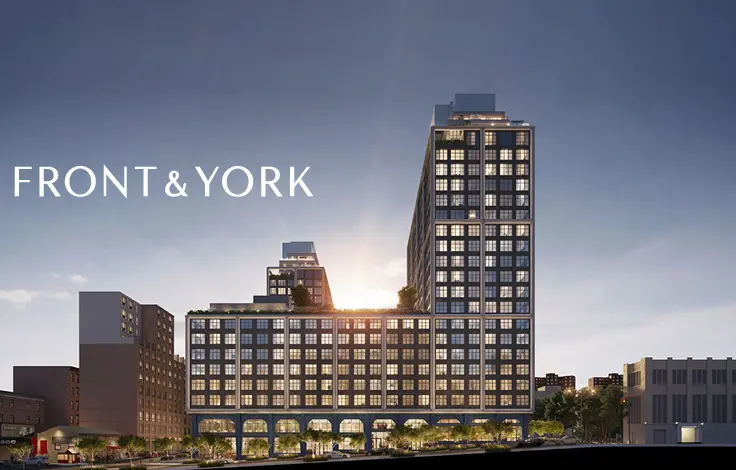
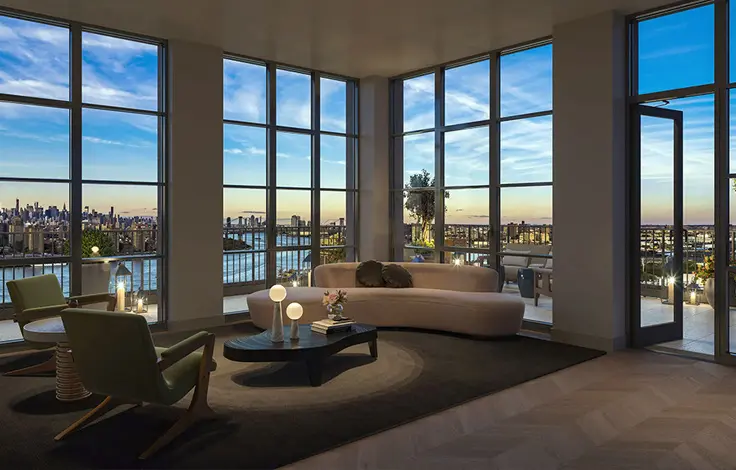

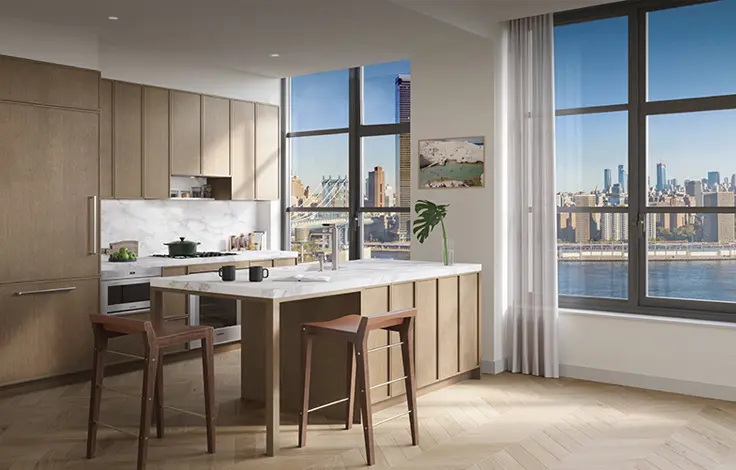
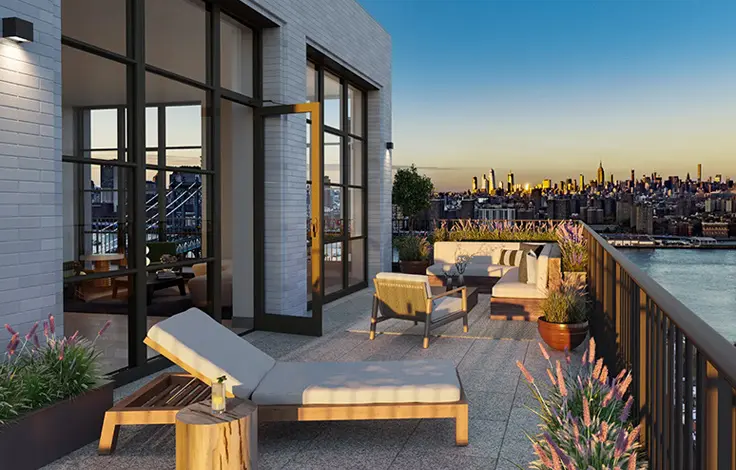
 6sqft delivers the latest on real estate, architecture, and design, straight from New York City.
6sqft delivers the latest on real estate, architecture, and design, straight from New York City.
